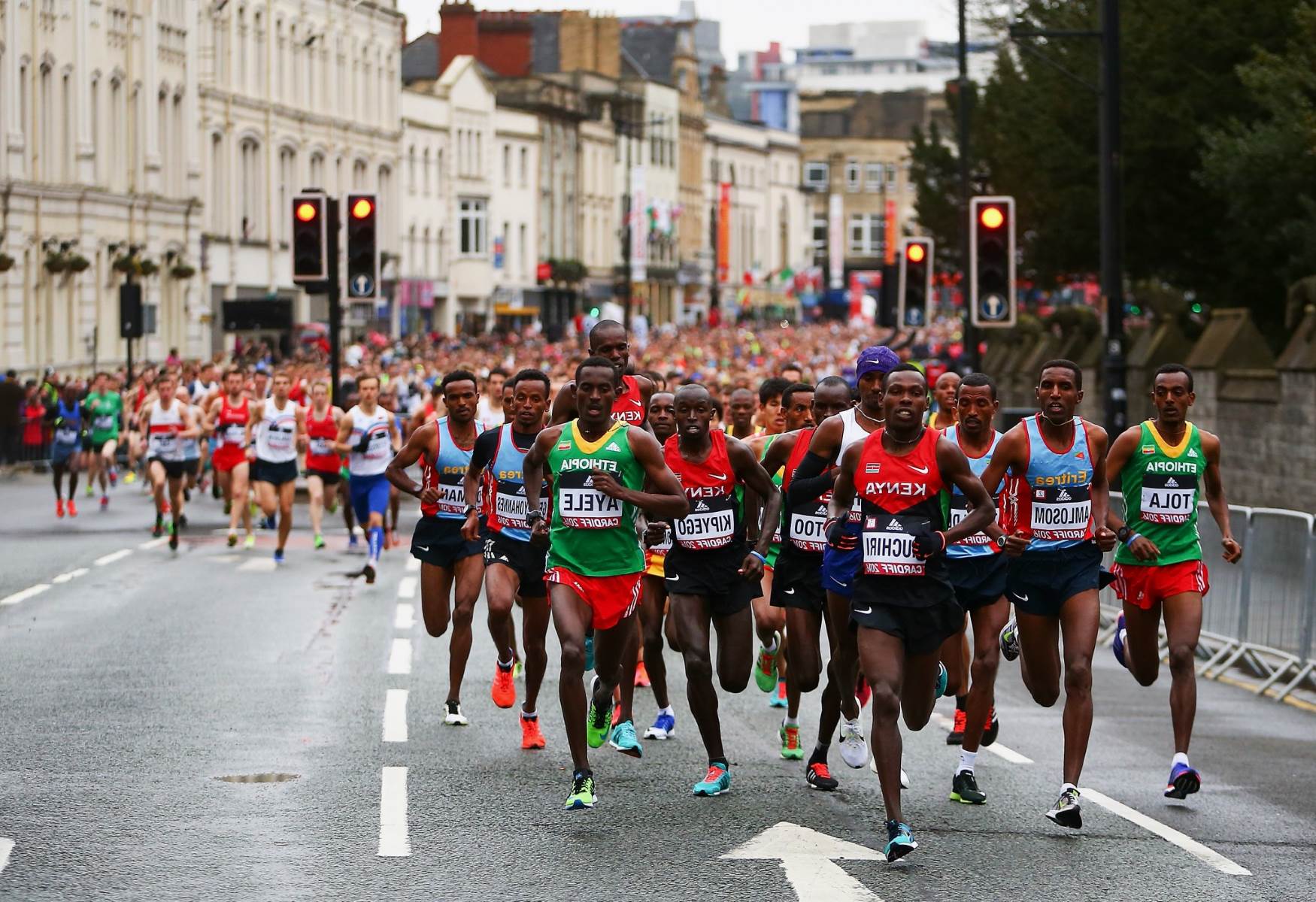Home>Training for Specific Goals>Endurance>The Secrets Of A Running Expert’s Endurance


Endurance
The Secrets Of A Running Expert’s Endurance
Published: February 20, 2024
Discover the secrets to building endurance from a running expert. Learn how to improve your stamina and reach your fitness goals. Unlock the key to lasting endurance today!
(Many of the links in this article redirect to a specific reviewed product. Your purchase of these products through affiliate links helps to generate commission for Therunningadvisor.com, at no extra cost. Learn more)
Table of Contents
The mindset of a running expert
The mindset of a running expert is a powerful and essential component of their success in building and maintaining endurance. It encompasses mental resilience, determination, and a positive attitude that propels them through the toughest challenges. Here's a closer look at the key elements that define the mindset of a running expert:
Mental Resilience
Running experts possess unwavering mental resilience, allowing them to push through physical and mental barriers. They understand that endurance is not solely a physical feat but also a mental one. When faced with fatigue, discomfort, or self-doubt, they draw upon their mental strength to persevere. This resilience enables them to tackle long distances and arduous terrains with unwavering determination.
Goal-Oriented Mindset
Running experts set clear, achievable goals and work tirelessly to attain them. Whether it's completing a marathon, improving their personal best, or conquering challenging trails, they approach each goal with a strategic mindset. By breaking down their objectives into manageable milestones, they maintain focus and drive throughout their training and races.
Positive Self-Talk
Maintaining a positive internal dialogue is a hallmark of the running expert's mindset. They harness the power of positive self-talk to overcome obstacles and stay motivated during grueling runs. By cultivating a mindset rooted in self-belief and optimism, they can conquer mental hurdles and sustain their endurance over long distances.
Adaptability
Adaptability is a crucial aspect of the running expert's mindset. They understand that every run presents unique challenges, from unpredictable weather conditions to fluctuating energy levels. Embracing adaptability allows them to adjust their pace, breathing, and strategy as needed, ensuring they remain resilient and adaptable in the face of adversity.
Read more: Unlocking The Secrets Of Running Pace
Passion and Purpose
Above all, running experts approach their craft with a deep sense of passion and purpose. Their love for running fuels their endurance journey, propelling them forward even when the going gets tough. This intrinsic motivation, coupled with a clear sense of purpose, sustains their commitment to long-term training and fosters a resilient mindset that is essential for enduring the rigors of distance running.
In essence, the mindset of a running expert is a potent blend of mental resilience, goal-oriented focus, positive self-talk, adaptability, and unwavering passion. It is this mindset that sets them apart, enabling them to conquer the physical and mental challenges of long-distance running with unwavering determination and grace.
Training techniques for building endurance
Building endurance is a multifaceted process that requires a strategic approach to training. Running experts employ a variety of techniques to enhance their stamina, resilience, and overall endurance capacity. Here's a comprehensive look at the training techniques that form the foundation of endurance building:
Long Slow Distance (LSD) Runs
LSD runs are a cornerstone of endurance training, involving sustained, moderate-intensity running over extended distances. These runs are designed to improve cardiovascular efficiency, enhance muscular endurance, and bolster mental resilience. By gradually increasing the duration of these runs, runners adapt to prolonged physical exertion, laying the groundwork for enduring long-distance races.
Interval Training
Interval training alternates between high-intensity bursts of running and periods of active recovery. This technique enhances endurance by challenging the cardiovascular system and improving the body's ability to recover from intense efforts. By incorporating intervals into their training regimen, running experts elevate their anaerobic threshold, enabling them to sustain higher speeds for longer durations.
Read more: 5K Run: Boost Your Endurance And Fitness
Hill Repeats
Hill repeats involve running uphill at a challenging incline, followed by a recovery period and repeated efforts. This technique builds strength, power, and mental fortitude, essential for conquering hilly terrains and maintaining speed during races. By incorporating hill repeats into their training, runners develop the muscular endurance and mental resilience necessary for enduring uphill segments with confidence.
Fartlek Training
Fartlek, a Swedish term for "speed play," blends continuous running with varying speeds and intensities. This versatile training technique simulates the unpredictable pace of race conditions, preparing runners to adapt to changing speeds and terrains. Fartlek training enhances both aerobic and anaerobic endurance, fostering a well-rounded capacity for sustained effort across diverse running environments.
Tempo Runs
Tempo runs involve sustained efforts at a challenging, yet sustainable pace, typically at or slightly below race pace. By incorporating tempo runs into their training, runners improve their lactate threshold, enabling them to sustain higher speeds for longer durations without succumbing to fatigue. This technique hones the ability to maintain a strong, steady pace, a vital asset for endurance running.
Recovery Runs
Recovery runs are gentle, low-intensity sessions that facilitate active recovery and promote circulation without inducing additional fatigue. These runs play a crucial role in the overall training program, allowing the body to adapt to previous efforts while minimizing the risk of overtraining. By integrating recovery runs into their routine, running experts strike a balance between challenging workouts and essential recovery periods.
Incorporating these training techniques into a comprehensive and well-structured training plan is essential for building endurance. By embracing the diversity of these methods, running experts cultivate the physical and mental attributes necessary to conquer long distances, surmount challenging terrains, and achieve enduring success in their running endeavors.
Read more: Expert Advice On Splayed Feet And Running
Nutrition and hydration tips for long-distance running
Proper nutrition and hydration are fundamental pillars of long-distance running, playing a pivotal role in sustaining energy levels, optimizing performance, and supporting overall well-being. Running experts prioritize a balanced approach to fueling their bodies, ensuring they have the necessary nutrients and fluids to endure the demands of extended runs. Here are essential nutrition and hydration tips for long-distance running:
Pre-Run Fueling
Before embarking on a long-distance run, it's crucial to consume a balanced meal that provides a combination of carbohydrates, protein, and healthy fats. Carbohydrates serve as the primary fuel source for endurance activities, while protein aids in muscle repair and recovery. Opt for easily digestible options such as oatmeal, whole grain toast with nut butter, or yogurt with fruit. Additionally, staying hydrated before the run is essential to maintain optimal fluid levels.
Hydration Strategies
Maintaining proper hydration throughout the run is paramount for sustaining endurance and preventing dehydration. Running experts often carry a handheld water bottle or utilize hydration vests to ensure consistent access to fluids. Hydration packs with integrated reservoirs are also popular for longer runs, allowing runners to hydrate without disrupting their stride. Electrolyte-enhanced drinks or electrolyte tablets can replenish essential minerals lost through sweat, supporting hydration and muscle function.
Fueling During the Run
For runs lasting longer than 60-90 minutes, it's essential to replenish glycogen stores and maintain energy levels. Running experts often rely on energy gels, chews, or sports drinks to provide a quick source of carbohydrates and electrolytes. These convenient fueling options are easily portable and rapidly absorbed, offering a valuable energy boost during extended efforts. Additionally, consuming small, easily digestible snacks such as bananas, energy bars, or dates can provide sustained energy without causing gastrointestinal distress.
Read more: Expert Advice For Running In Hot Weather
Post-Run Recovery Nutrition
After completing a long-distance run, prioritizing post-run nutrition is vital for replenishing energy stores and supporting muscle recovery. Running experts emphasize the importance of consuming a balanced meal or snack within the post-run window, typically within 30-60 minutes. This meal should include a blend of carbohydrates and protein to facilitate glycogen replenishment and muscle repair. Chocolate milk, a popular choice among runners, offers an ideal ratio of carbohydrates to protein, promoting efficient recovery.
Nutrient-Dense Foods
Incorporating nutrient-dense foods into the overall diet is essential for supporting long-term endurance and overall health. Running experts emphasize the consumption of lean proteins, colorful fruits and vegetables, whole grains, and healthy fats. These foods provide a spectrum of essential vitamins, minerals, and antioxidants, bolstering immune function, promoting recovery, and sustaining energy levels throughout training and racing.
By integrating these nutrition and hydration tips into their long-distance running regimen, running experts optimize their performance, enhance their endurance capacity, and prioritize their overall well-being. A balanced approach to fueling the body ensures that they are adequately prepared to conquer the physical and mental challenges of extended runs, ultimately contributing to their long-term success in the realm of endurance running.
Recovery strategies for maintaining endurance
Recovery is a critical yet often overlooked aspect of endurance training. Running experts understand that effective recovery strategies are essential for sustaining endurance, preventing injury, and optimizing performance. By prioritizing recovery, they ensure that their bodies are adequately prepared to tackle the rigors of long-distance running. Here's a comprehensive exploration of the recovery strategies employed by running experts to maintain their endurance:
Adequate Rest and Sleep
Quality rest and sufficient sleep are foundational elements of effective recovery. Running experts prioritize adequate rest periods between intense training sessions, allowing their bodies to repair and adapt to the physiological stress imposed by running. Additionally, they recognize the restorative power of sleep in facilitating muscle recovery, hormone regulation, and mental rejuvenation. By consistently prioritizing rest and aiming for 7-9 hours of quality sleep per night, they optimize their body's ability to endure prolonged physical exertion.
Read more: Damian Hall’s Secrets To Staying Injury Free
Active Recovery Techniques
Incorporating active recovery techniques into their training regimen is a hallmark of running experts' approach to maintaining endurance. These techniques may include gentle cross-training activities such as cycling, swimming, or yoga, which promote circulation, alleviate muscle soreness, and enhance flexibility. By engaging in low-impact, complementary exercises, they facilitate recovery while maintaining overall fitness and mobility.
Foam Rolling and Mobility Work
Foam rolling and targeted mobility exercises are integral components of the recovery toolkit for running experts. These practices aid in releasing muscular tension, improving flexibility, and promoting blood flow to fatigued muscles. By incorporating foam rolling sessions and mobility drills into their post-run routine, they mitigate the risk of overuse injuries and support the body's capacity for enduring prolonged running endeavors.
Nutrient-Rich Recovery Meals
Following a demanding run, running experts prioritize nutrient-rich recovery meals to replenish energy stores and support muscle repair. These meals typically feature a blend of carbohydrates, lean proteins, and healthy fats to facilitate glycogen replenishment and tissue recovery. By consuming well-balanced post-run meals, they accelerate the recovery process, ensuring that their bodies are primed for subsequent training sessions and long-distance races.
Hydration and Electrolyte Replenishment
Proper hydration and electrolyte replenishment are vital components of recovery for maintaining endurance. Running experts emphasize the importance of hydrating adequately post-run, as prolonged exercise can lead to fluid and electrolyte depletion. By consuming electrolyte-enhanced beverages or incorporating electrolyte tablets into their post-run routine, they restore the body's fluid balance and support optimal muscle function, essential for enduring subsequent training efforts.
Mindfulness and Stress Management
Mindfulness practices and stress management techniques play a significant role in the recovery strategies of running experts. They recognize the impact of mental and emotional well-being on physical recovery and endurance maintenance. Engaging in activities such as meditation, deep breathing exercises, or nature walks allows them to reduce stress levels, promote mental clarity, and enhance overall resilience, contributing to sustained endurance capacity.
In essence, the implementation of comprehensive recovery strategies is paramount for running experts seeking to maintain their endurance. By integrating rest, active recovery techniques, nutrient-rich meals, hydration practices, and mindfulness into their training regimen, they foster a holistic approach to recovery that supports their long-term success in the realm of endurance running.
The importance of rest and recovery in endurance training
Rest and recovery are indispensable components of endurance training, playing a pivotal role in the sustained success and well-being of running experts. These essential periods of respite are not merely breaks from physical exertion; rather, they are integral phases during which the body undergoes repair, adaptation, and rejuvenation. Here's a detailed exploration of the profound significance of rest and recovery in the context of endurance training.
Physiological Repair and Adaptation
Rest and recovery periods provide the body with the opportunity to repair and adapt to the physiological stress induced by prolonged running. During these intervals, muscle fibers undergo repair and regeneration, bolstering their resilience and capacity for enduring subsequent training sessions. Additionally, the cardiovascular system, including the heart and blood vessels, undergoes adaptive changes, enhancing its efficiency and endurance capacity. These physiological adaptations are essential for fortifying the body against the demands of long-distance running, ultimately contributing to improved performance and resilience.
Injury Prevention and Longevity
Adequate rest and recovery play a crucial role in injury prevention, a cornerstone of long-term running success. Overuse injuries, such as stress fractures, tendonitis, and muscle strains, often result from inadequate recovery and excessive training load. By incorporating rest periods into their training regimen, running experts mitigate the risk of overuse injuries, ensuring that their bodies remain resilient and injury-free. Furthermore, prioritizing rest supports the longevity of a runner's career, allowing them to sustain their passion for running and participate in endurance events for years to come.
Hormonal Balance and Mental Well-being
Rest and recovery are essential for maintaining hormonal balance and mental well-being, both of which are integral to enduring success in running. Adequate rest supports the regulation of cortisol, a stress hormone that, when elevated due to chronic training stress, can impede recovery and compromise overall health. Furthermore, rest periods allow runners to recharge mentally, reducing the risk of burnout and enhancing their motivation and focus during subsequent training sessions and races. By nurturing mental well-being through rest and recovery, running experts sustain their passion for running and approach their endeavors with a rejuvenated mindset.
Performance Optimization
Rest and recovery are fundamental for optimizing performance in endurance training. These periods of respite allow the body to supercompensate, a process wherein it adapts to the stress of training and emerges stronger and more resilient. By strategically incorporating rest and recovery into their training plan, running experts maximize the benefits of their hard work, ensuring that they are adequately prepared to tackle the physical and mental challenges of long-distance running. This approach ultimately leads to improved performance, enhanced endurance, and a reduced risk of training plateaus or performance stagnation.
In essence, the importance of rest and recovery in endurance training cannot be overstated. These vital periods of respite facilitate physiological repair and adaptation, prevent injuries, support hormonal balance and mental well-being, and optimize performance. By embracing rest as a strategic asset rather than a mere pause in training, running experts lay the foundation for enduring success in their pursuit of long-distance running excellence.
Injury prevention and management for long-term running success
In the realm of long-distance running, injury prevention and management are paramount for ensuring sustained success and longevity in the sport. Running experts recognize that a proactive approach to mitigating the risk of injuries and addressing any potential issues is essential for maintaining their endurance and overall well-being. Here's a comprehensive exploration of the strategies and practices employed by running experts to prevent and manage injuries, safeguarding their long-term running success.
Comprehensive Warm-Up and Cool-Down Routines
Prior to embarking on a run, running experts prioritize thorough warm-up routines to prepare their muscles, tendons, and ligaments for the impending physical exertion. Dynamic stretching, mobility exercises, and light jogging are integral components of their warm-up, promoting blood flow, flexibility, and neuromuscular activation. Similarly, post-run cool-down routines encompass static stretching, foam rolling, and gentle mobility work, aiding in muscle recovery and reducing the risk of post-exercise tightness and discomfort.
Read more: Expert Tips For Running A Sub 20 5k
Progressive Training Load and Periodization
Running experts adhere to a structured training approach that incorporates progressive increases in mileage, intensity, and duration while allowing for adequate recovery periods. This periodized training model mitigates the risk of overuse injuries by balancing challenging workouts with essential rest and recovery. By gradually building their endurance capacity and strategically varying training stimuli, they minimize the likelihood of sustaining injuries due to excessive training load or inadequate recovery.
Strength and Stability Training
Integrating strength and stability exercises into their training regimen is a cornerstone of injury prevention for running experts. Targeted strength training routines, focusing on the lower body, core, and stabilizing muscles, fortify the body against the repetitive impact and demands of long-distance running. By enhancing muscular strength, balance, and joint stability, they reduce the risk of common running-related injuries such as IT band syndrome, patellofemoral pain, and Achilles tendonitis.
Biomechanical Analysis and Footwear Assessment
Running experts prioritize biomechanical analysis and footwear assessment to address potential gait abnormalities, imbalances, or inadequate shoe support. By seeking professional guidance and utilizing gait analysis technology, they identify and rectify biomechanical inefficiencies that may predispose them to injuries. Additionally, selecting appropriate footwear tailored to their running style and foot structure is crucial for minimizing the risk of overuse injuries and enhancing overall comfort and performance.
Proactive Injury Management and Rehabilitation
In the event of an injury, running experts adopt a proactive approach to injury management and rehabilitation. This involves seeking timely medical evaluation, adhering to prescribed treatment plans, and engaging in targeted rehabilitation exercises under the guidance of healthcare professionals. By addressing injuries promptly and following a structured rehabilitation program, they expedite the recovery process and minimize the impact of injuries on their long-term running endeavors.
Listen to the Body and Adaptation
Above all, running experts prioritize listening to their bodies and adapting their training as needed to prevent injuries. They remain attuned to subtle signs of fatigue, discomfort, or potential overuse, adjusting their training load, intensity, or duration accordingly. This intuitive approach allows them to proactively address any warning signals from their bodies, ultimately minimizing the risk of injuries and sustaining their long-term running success.
In essence, injury prevention and management are foundational pillars of long-term running success for running experts. By implementing comprehensive warm-up and cool-down routines, embracing periodized training, integrating strength and stability exercises, prioritizing biomechanical analysis, and adopting a proactive approach to injury management, they safeguard their endurance and well-being. Through these proactive measures, running experts fortify their bodies against the rigors of long-distance running, ensuring that they can pursue their passion for running with resilience and longevity.







